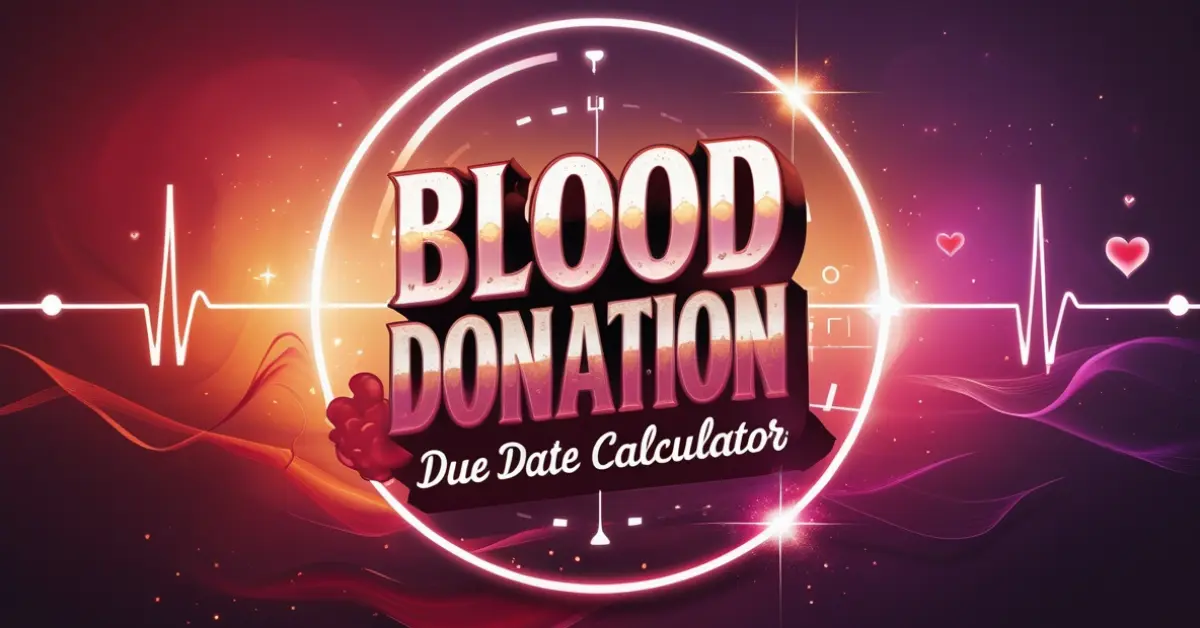Donating blood saves lives. It’s a generous act that helps patients in need. But after donating, you must wait before giving blood again. So, how do you know your next blood donation date? Our Blood Donation Due Date Calculator makes it easy. Simply enter your last donation date and type, and we’ll tell you when you can donate again.
Blood Donation Date Calculator
When Can I Donate Blood Again?
Your next donation date depends on:
- The type of blood donation (whole blood, platelets, plasma, or double red cells)
- The date of your last donation
Each donation type has a different waiting period:
| Donation Type | Waiting Period |
|---|---|
| Whole Blood | 56 days (8 weeks) |
| Platelets | 7 days (1 week) |
| Plasma | 28 days (4 weeks) |
| Double Red Cells | 112 days (16 weeks) |
Our Blood Donation Schedule Planner helps you track when you can donate next, so you never miss an opportunity to save lives.
You may also like:
- Best Sleep Cycle Calculator to Improve Your Sleep Quality
- Best HbA1c Calculator to Track Glycosylated Hemoglobin for Diabetes
How to Use Our Blood Donation Due Date Calculator?
Using our Blood Donation Date Calculator is simple:
- Enter your last donation date.
- Select your donation type.
- Click Calculate.
The Blood Donation Cycle Tracker will instantly show your next eligible donation date.
Example:
If you donated whole blood on June 1, your next donation date will be July 27 (after 56 days).
Who Can Donate Blood?
Most healthy adults can donate blood if they meet these basic requirements:
| Requirement | Details |
|---|---|
| Minimum Age | 17 years (16 with parental consent in some areas) |
| Minimum Weight | 110 lbs (50 kg) |
| Hemoglobin Level | Must be within a healthy range |
| General Health | Must feel fit and well on donation day |
Who Cannot Donate Blood?
Some people may not be eligible to donate due to health conditions, travel history, or recent medical procedures. Here are common reasons for deferral:
| Reason | Waiting Period |
|---|---|
| Low iron levels (anemia) | Until hemoglobin returns to normal |
| Recent tattoo or piercing | 3-6 months in some areas |
| Certain infections (HIV, hepatitis, etc.) | Permanent deferral |
| Pregnancy or recent childbirth | Wait 6 weeks after delivery |
| Travel to malaria-risk area | Wait 3 months |
How Much Blood Is Donated at Once?
The amount of blood donated varies based on the type of donation:
| Donation Type | Amount Collected |
|---|---|
| Whole Blood | 1 pint (450-500 mL) |
| Platelets | 1-2 units (varies) |
| Plasma | 1-2 units (varies) |
| Double Red Cells | 2 units |
Your body replaces lost blood quickly, but you must wait for the blood donation interval before donating again.
Why Use a Blood Donation Schedule Planner?
Tracking your donation dates helps you:
- Donate safely without over-donating.
- Plan ahead for your next donation.
- Keep your blood supply healthy for recipients.
- Ensure you meet eligibility criteria before donating.
Check out some of the Best BMI Scales on the Market.
Common Myths About Blood Donation
Many myths about blood donation prevent people from donating. Let’s clear up some of them:
| Myth | Reality |
|---|---|
| Giving blood is painful | You may feel a small pinch, but the process is mostly painless. |
| Donating blood makes you weak | Your body replaces the lost blood quickly, so weakness is temporary. |
| You can catch diseases from blood donation | Blood donation is done with sterile, single-use equipment. |
| Vegetarians cannot donate blood | As long as hemoglobin levels are normal, vegetarians can donate too. |
Blood Donation Health Tips
- Stay Hydrated: Drink plenty of water before and after donating.
- Eat Iron-Rich Foods: Helps maintain hemoglobin levels.
- Get Enough Rest: Avoid strenuous activities after donation.
- Monitor Your Health: If you feel unwell, wait until you recover.
Conclusion
Blood donation is a small act that makes a big difference. Be a hero—donate blood today! Bookmark our Blood Donation Frequency Calculator to track your donation dates easily. Donate when eligible, stay healthy, and help save more lives!
